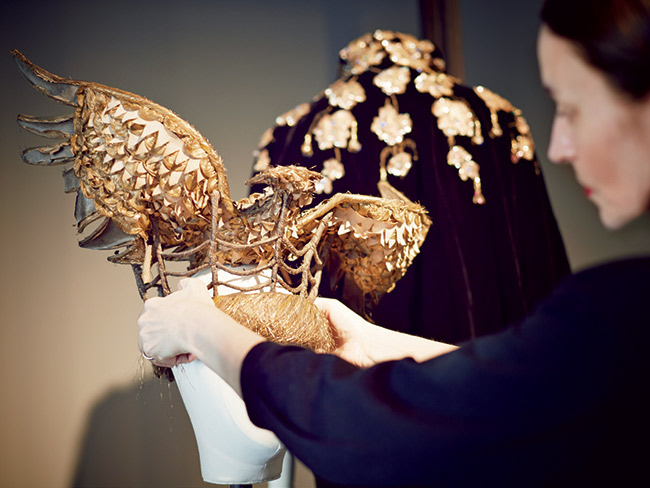Consider the Fashion Project a welcome addition to Miami’s cultural whirl. Touted as an “experimental space” for exploring the rich milieu of craft, innovation, and meaning surrounding fashion, it certainly seems like a natural fit for a city that hardly needs an excuse to flock to a bold catwalk strut or a fresh unveiling. Moreover, funded by the Whitman family and housed within their Bal Harbour Shops—which already acts as a veritable shrine to both the high-fashion industry and a certain well-turned-out slice of the international beau monde—the Fashion Project appears to have found a more than appropriate home.
Conceived by Cathy Leff, former director of The Wolfsonian-Florida International University, and with rotating shows curated by the London-based Judith Clark, known for her academically minded fashion exhibitions everywhere from England’s Victoria and Albert Museum to France’s Palais de Tokyo, the Fashion Project aims to get locals talking. Part of that discussion is intended to be primed by Clark’s exhibits, which have already drawn on eye-raisingly rare items, from a 1930s Elsa Schiaparelli cape to Hussein Chalayan’s notorious motorized dress from 1999. And part will no doubt arise from the string of fashion notables making their way to the space for lectures and panel discussions. Ocean Drive sat down with Clark to discuss.
Do you recall the initial thinking behind the Fashion Project?
It very much grew out of a conversation with Cathy Leff, who came and spoke with me in London and explained that she wanted to do a project that added a cultural dimension to the Bal Harbour Shops. I haven’t worked exclusively within museums—I’ve done projects for Selfridges [a United Kingdom-based department store]—and I love the crossovers that exist within this field more and more. So Cathy was pushing on an open door.
In hindsight, it seems odd that Miami’s established art museums haven’t already delved deeply into fashion. After all, it’s hard to talk about Miami without also talking about Miamians and their dedication to fashion.
Fashion is often like that! You can’t believe it hasn’t been already said. It’s as though “fashion” is a dirty word, intellectually; it’s really dragging behind in terms of curatorial debate. Which is what I love about staging Fashion Project in Miami, where it has this reputation for being fashion-obsessed… You have a swapping of aesthetics, but there’s still a resistance on the part of the museums at being described as too close to retail. There’s a phobia about it. I don’t happen to share that phobia. I think anything that’s evocative and true to the narrative you want to tell is fine.
 picture: princess style wedding dresses“These exhibitions are an invitation to have conversations about fashion beyond ‘how much is it?’”—Judith Clark
picture: princess style wedding dresses“These exhibitions are an invitation to have conversations about fashion beyond ‘how much is it?’”—Judith Clark
It’s a bit of a cliché to talk about the globalization of fashion, but is there a difference in launching Fashion Project Miami compared to, say, a Fashion Project Chicago?
Obviously, within the Bal Harbour Shops, there’s a tradition of exquisite high-end fashion. But when you have so many pieces that are already museumworthy downstairs, what else can be said about it? We can discover what kind of debate there might be around the subject in Miami. Fashion Project is an excuse to open this conversation in a city that is now so much the center of attention.
Some fashion curators have held up designers as gifted artists in their own right, akin to film scholars pushing auteur theory in the 1960s as a way to combat skeptics who refused to look at movies as art. But you’ve dismissed this kind of fashion talk as “the cult of the genius.” Why?
For a moment, that was all people could say, as though there was this scramble to legitimize fashion: Oh, these designers are just as artistic as Warhol! Some may be—and some are, as far as I’m concerned. But it’s as though that distracted from the ability to talk about the dress. Fashion isn’t necessarily art. It exists within different criteria of creation. But the problem there is that within our culture, that diminishes it. It does have another commercial reality. It’s like asking, “Is a car art?” It’s within the realm of applied arts, and it has its own distinct logic.
So when we talk about fashion, sometimes we’re speaking about art, sometimes we’re speaking about business, and sometimes we’re talking about the sweet spot between those overlapping worlds?
There’s room for all those conversations—that’s part of the Fashion Project. The point is not that, at the end of a year’s exhibitions, everyone goes home happy because we’ve cracked it: Right, here’s the definition of fashion. Quite the opposite. All the problems around fashion are going to be raised, not necessarily answered. These exhibitions are an invitation to have conversations about fashion beyond “How much is it?” and “Does it make me look fat?”
read more: mermaid style wedding dresses









